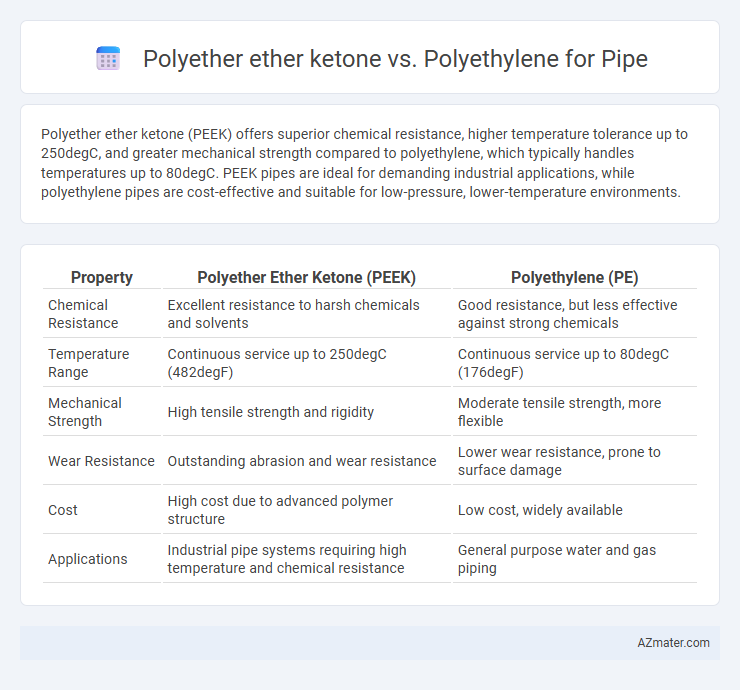Polyether ether ketone (PEEK) offers superior chemical resistance, higher temperature tolerance up to 250degC, and greater mechanical strength compared to polyethylene, which typically handles temperatures up to 80degC. PEEK pipes are ideal for demanding industrial applications, while polyethylene pipes are cost-effective and suitable for low-pressure, lower-temperature environments.
Table of Comparison
| Property | Polyether Ether Ketone (PEEK) | Polyethylene (PE) |
|---|---|---|
| Chemical Resistance | Excellent resistance to harsh chemicals and solvents | Good resistance, but less effective against strong chemicals |
| Temperature Range | Continuous service up to 250degC (482degF) | Continuous service up to 80degC (176degF) |
| Mechanical Strength | High tensile strength and rigidity | Moderate tensile strength, more flexible |
| Wear Resistance | Outstanding abrasion and wear resistance | Lower wear resistance, prone to surface damage |
| Cost | High cost due to advanced polymer structure | Low cost, widely available |
| Applications | Industrial pipe systems requiring high temperature and chemical resistance | General purpose water and gas piping |
Introduction to Pipe Materials: PEEK vs Polyethylene
Polyether ether ketone (PEEK) offers superior mechanical strength, chemical resistance, and high-temperature tolerance compared to polyethylene, making it ideal for demanding pipe applications in aerospace and industrial sectors. Polyethylene pipes, particularly high-density polyethylene (HDPE), are favored for cost-effective, flexible, and corrosion-resistant solutions in water and gas distribution systems. The choice between PEEK and polyethylene hinges on specific operational conditions, balancing PEEK's durability and thermal stability against polyethylene's affordability and ease of installation.
Chemical Structure and Composition
Polyether ether ketone (PEEK) features a rigid aromatic backbone composed of repeating ether and ketone groups, granting it exceptional thermal stability and chemical resistance ideal for high-performance pipe applications. Polyethylene (PE), characterized by a simpler hydrocarbon chain of repeating ethylene units, offers flexibility and chemical inertness but lacks the high temperature tolerance and mechanical strength of PEEK. The presence of aromatic rings and polar functional groups in PEEK's composition significantly enhances its durability and resistance to aggressive chemicals compared to the nonpolar, saturated structure of polyethylene.
Mechanical Strength and Durability
Polyether ether ketone (PEEK) exhibits significantly higher mechanical strength than polyethylene (PE), maintaining structural integrity under high stress and elevated temperatures up to 250degC. PEEK's superior durability stems from its excellent chemical resistance, low wear rate, and exceptional fatigue resistance, making it ideal for demanding industrial pipe applications. Polyethylene, while cost-effective and flexible with good chemical resistance, is limited in mechanical strength and temperature tolerance, typically peaking around 80degC, which restricts its use in high-performance piping systems.
Temperature and Pressure Resistance
Polyether ether ketone (PEEK) exhibits superior temperature resistance, withstanding continuous use temperatures up to 250degC compared to polyethylene's typical maximum of 80degC. In terms of pressure resistance, PEEK maintains high mechanical strength and dimensional stability under pressures exceeding 100 MPa, whereas polyethylene pipes generally perform well under lower pressures around 10-20 MPa. These characteristics make PEEK ideal for high-temperature, high-pressure piping applications requiring advanced chemical and mechanical durability.
Corrosion and Chemical Resistance
Polyether ether ketone (PEEK) exhibits superior corrosion and chemical resistance compared to polyethylene (PE), making it ideal for piping systems exposed to harsh chemicals and aggressive environments. PEEK maintains structural integrity and resists a wide range of acids, bases, and solvents, whereas polyethylene can degrade or swell when exposed to strong chemicals over time. This enhanced chemical stability ensures longer service life and reduced maintenance in industrial applications requiring high-performance pipe materials.
Weight and Flexibility Comparison
Polyether ether ketone (PEEK) pipes offer superior weight advantages with a density of approximately 1.3 g/cm3, significantly lighter than polyethylene (PE) pipes, which range from 0.91 to 0.96 g/cm3. In terms of flexibility, PE pipes excel due to their lower modulus of elasticity around 0.2-0.4 GPa, allowing higher deformation without cracking, whereas PEEK, with a modulus near 3.6 GPa, provides enhanced rigidity and dimensional stability but reduced flexibility. This makes polyethylene more suitable for applications requiring bending and impact resistance, while PEEK is preferred for high-performance, weight-sensitive environments requiring strength and chemical resistance.
Installation and Maintenance Considerations
Polyether ether ketone (PEEK) pipes offer superior chemical resistance and high-temperature tolerance, reducing the frequency of replacements during maintenance compared to polyethylene (PE) pipes. Installation of PEEK pipes requires specialized welding techniques and precise handling due to their stiffness and higher melting point, whereas PE pipes allow easier fusion and flexibility on site. Maintenance costs for PEEK pipes are generally lower in aggressive environments, while PE pipes may require more frequent inspections and repairs in similar conditions.
Cost Analysis: PEEK vs Polyethylene Pipes
Polyether ether ketone (PEEK) pipes generally have a higher upfront cost compared to polyethylene pipes due to their superior mechanical properties and chemical resistance. While polyethylene pipes offer a lower initial investment, their shorter lifespan and limited temperature tolerance can lead to increased maintenance expenses over time. Cost analysis often favors polyethylene for budget-sensitive projects, but PEEK provides long-term value in demanding industrial applications where durability and performance are critical.
Typical Applications in Industry
Polyether ether ketone (PEEK) is extensively used in aerospace, automotive, and chemical processing industries due to its exceptional mechanical strength, chemical resistance, and high-temperature stability. Polyethylene (PE) pipes are predominantly applied in water supply, gas distribution, and sewage systems because of their flexibility, corrosion resistance, and cost-effectiveness. PEEK excels in demanding environments requiring durability and thermal resistance, while polyethylene is favored for large-scale municipal and industrial fluid transportation where economic efficiency is crucial.
Environmental Impact and Longevity
Polyether ether ketone (PEEK) exhibits superior environmental resistance and longevity compared to polyethylene (PE) when used in piping applications. PEEK's high chemical stability and temperature resistance contribute to a longer service life, reducing replacement frequency and waste generation. Polyethylene, while cost-effective and recyclable, has lower resistance to UV radiation and chemical degradation, resulting in shorter lifespan and increased environmental impact over time.

Infographic: Polyether ether ketone vs Polyethylene for Pipe
 azmater.com
azmater.com